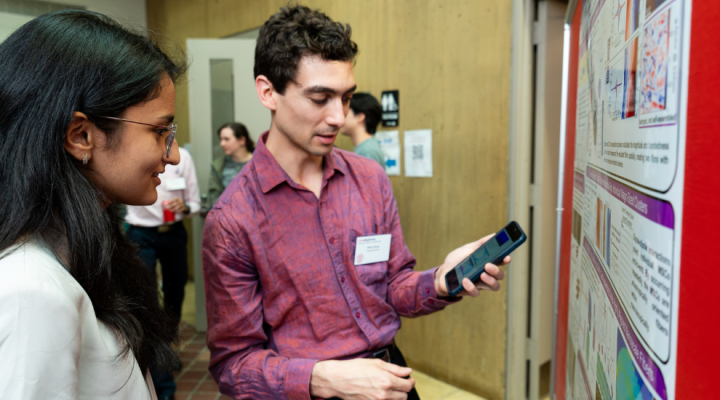John Eom, doctoral student in Cornell’s School of Materials Science and Engineering (MSE), says of himself, “I’m not generally a risk-taker but in my professional life I do tend to try things that are high risk/high reward. That is how I ended up in Jin’s lab.” “Jin” is MSE Assistant Professor Jin Suntivich. When Eom first got to Cornell after earning his undergraduate degree in engineering from Harvey Mudd College in Claremont, California Suntivich proposed a daring research project that appealed strongly to Eom’s boundary-pushing side.
“Jin said that a big challenge current fuel cells face is that the platinum catalysts they rely on are not as efficient as we want them to be,” says Eom. “He proposed that we use Stimulated Raman Spectroscopy (SRS) to figure out why. And from there to work out how to improve catalytic efficiency.” It was only once Eom learned more about the difficulty involved in actually doing what Suntivich proposed that he saw just how big a task he had signed up for. “No, in the end we didn’t figure out exactly how platinum catalysis works at the molecular level in fuel cells,” says Eom now with a bemused smile, “but we have taken big steps in the field of in situ spectroscopy of electrochemically interesting materials in aqueous systems.”
Eom was born in Bloomington, Indiana as his father earned his doctorate there. As a young child he moved to Ohio for a short time and then to Seoul, South Korea, where he lived through his high school years. While attending an international high school in Seoul, Eom focused on sciences, but also took a lot of history classes simply because he was interested in them. When it was time to decide on a college for his undergraduate studies, Eom chose Harvey Mudd, where he majored in engineering while again taking numerous classes in archaeology.
During one of his Harvey Mudd summers, Eom worked as an intern with the Tesla battery team. His experience at Tesla helped him decide that he would need to earn a Ph.D. in order to do what he eventually wanted to do in the field, whether that was in academia or in industry. There are no graduate students at Harvey Mudd and Eom felt a bit out of his element as he began his search for a grad program that might suit his needs. He turned to the U.S. News and World Report and created a list eight or nine schools to apply to.
Eom narrowed his list down to two finalists. One of the factors that put Cornell over the top was his visit to the campus. “Of all the places I visited,” says Eom, “I felt most connected and welcomed by the people I met at Cornell.” The other factor was Eom’s experience with the faculty at Harvey Mudd. “I was close with many of the physics faculty there and when I asked, more than half of them were Cornell alumni,” says Eom. When combined with his conversation with Jin Suntivich, Cornell seemed like a good place for Eom to work on his doctorate.
Seven years later, Eom can say with certainty that he made the right choice. His work with SRS can improve researchers’ ability to understand how catalysts in general do what they do at the atomic level. Although he focused on catalysts for future renewable energy technologies, the principles of Eom’s research can be extended to catalysts present in many technologies currently in wide use, such as the pollution-fighting devices connected to most internal combustion engines in cars—catalytic converters. “My work is helping to provide a fundamental understanding of how catalysts work,” says Eom. “The better we can get at this, the more evidence we can add to a process that currently often relies on scientific intuition.” This would streamline the discovery process and allow engineers to make better, more efficient catalysts, “which could have a great effect in the real world,” says Eom.
When he is not thinking about catalysts and their atomic behavior, Eom plays soccer, publishes a soccer magazine, and perfects his cooking of various dishes (current projects include home-made dumplings and pasta arrabiata). He recently took a science communications class through local Public Broadcasting station WSKG. As a final project he and his friend created a three-minute video focused on the thermal properties important for cooking steak on a stovetop. The video is called “Meat Meets Heat” and you can see it here: https://www.youtube.com/watch?v=7Or1peLGxDE




